Metal Detection
Metal detection is the most commonly-used technology for finding metallic threats concealed on people. Hand-held metal detectors (HHMDs) and walk-through metal detectors (WTMDs) are common at almost all security checkpoints worldwide. Other types of metal detectors deployed in security applications include hand-worn metal detectors, that are donned similarly to gloves or strapped to the palm, and ground search devices, similar in operation to treasure-seeking metal detectors but designed specifically to find items related to threat objects.
HHMDs come in many shapes and sizes, from cylindrically-shaped batons to palm-sized cell phones. Some HHMDs have adjustable sensitivity that can be tuned to a level where large dental fillings can be detected. Hand-worn metal detectors typically do not have the detection sensitivity of HHMDs but, because they are worn, do not constrain the officer’s use of both hands during a search operation and often help direct a more detailed palpatory search. WTMDs are typically fixed in location although some models are available for transient deployment. WTMDs typically have multiple detection zones and these, along with appropriate indicators, can be used to assist in locating the object hidden on a person. The ground search metal detectors are often used at crime scenes to find various items of forensic interest and in correctional institutions where inmates are hiding or burying threat items and contraband in bedding, the yard, and other locations.
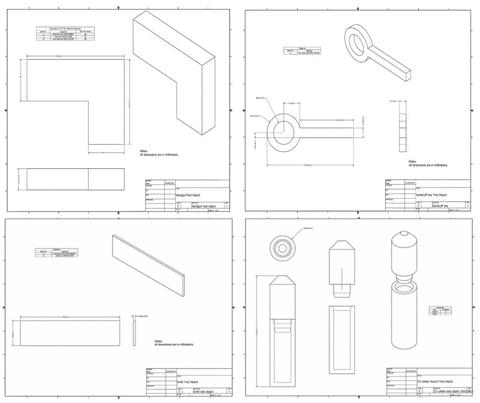
The threat objects and/or contraband that metal detectors are intended to find varies greatly amongst different agencies, different locations, and over time. For example, in a correctional-institution setting, the detection of contraband such as cigarette packs is very important because these items are used as currency, and cell phones because they provide disallowed communication with the outside world. Finding contraband concealed on or inside a body is often difficult using other technologies, but metal detectors can often find objects with this type of concealment. Threats do evolve, as well, and so must the ability of metal detectors to find these threats.
Metal detectors work by generating an alternating magnetic field that may interact with objects that are near this magnetic field. If the object is electrically conductive or magnetically permeable, the magnetic field of the metal detector will interact with the object. This interaction will result in an electromagnetic coupling that can be sensed by the metal detector. A metal detector should not be confused with a magnetometer, which is a device to measure the strength of a magnetic field.
Around 2000, NIST started the development of a facility and metrology capability to a) measure the performance of metal detectors, b) design and test the efficacy of test artifacts, and c) develop associated measurement uncertainties. This capability comprises a Cartesian robotic system for positioning the test object and delivering it to the metal detector, materials that emulate the electrical conductivity of human tissue over the operating frequency range of metal detectors (nominally between 100 Hz and 10 MHz), test artifacts, and data analysis software.
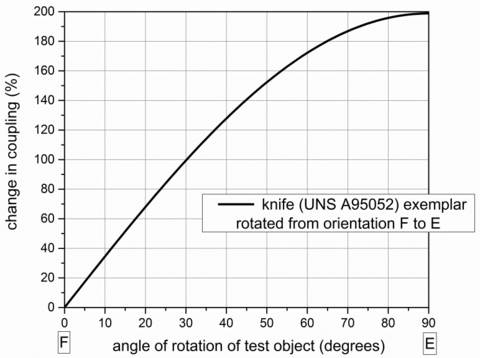
The test artifacts or exemplars are objects that, in the case of metal detectors, emulate the electromagnetic properties of actual threats objects or contraband items or classes of them but are not actual threat items and cannot be used as a threat item. Exemplar design is complex because both technical and nontechnical requirements have previously had an influence on these objects. A major improvement in exemplar design is represented in the National Institute of Justice (NIJ) HHMD standard and WTMD standard, NIJ Std 0601.01, “Walk-Through Metal Detectors for Use in Concealed Weapon and Contraband Detection,” and NIJ Std 0602.01,“Hand-Held Metal Detectors for Use in Concealed Weapon and Contraband Detection,” both created by NIST and published by NIJ in 2000. In these documentary standards, exemplars for different classifications of threat objects, including dimensional tolerances, and a logical threat classification scheme were introduced. In the 2003 revisions of the same documentary standards, material specifications, through the Unified Numbering System (UNS) classification scheme, were introduced. Although the UNS schema greatly reduced the variability in the material composition of the exemplars, it did not define the nominal values and tolerances for the electrical conductivity and the magnetic permeability of the metals used in the construction of the exemplars. These electromagnetic properties are of primary importance to the design and function of metal detector testing exemplars.
The Security Technologies Group (STG) staff has been intimately involved in the development of documentary performance standards for HHMDs starting in 1998 that resulted in the revision of the NIJ’s HHMD and WTMD standards that were published in 2000. The STG subsequently revised those documentary performance standards, resulting in NIJ standards that were published in 2003. These advancements to the NIJ standards were made under a philosophy that is similar to that found in national and international standard development organizations (SDOs), namely, balanced representation of the stakeholders, open to interested parties, fair consideration of dissenting opinions, and a process to address technical conflicts.
Around 2007, NIST started the process of revising the NIJ metal detector standards to incorporate values for the pertinent electromagnetic properties (electrical conductivity and magnetic permeability), measurement uncertainties, and improved measurement methods. To better enable the contribution of manufacturers and other relevant stakeholders, NIST initiated and subsequently led the development of metal detector standards through the ASTM in 2014. The first metal detector type addressed was the hand-worn metal detectors. The second was the hand-held metal detectors. Walk-through metal detectors will be addressed in the future.
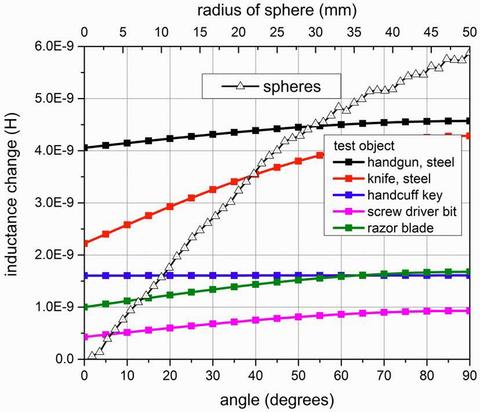
Hand-Held and Hand-Worn Metal Detectors
Hand-worn metal detectors (HWMDs) are not as pervasive a product as the HHMD, however, because they are a relatively new (since around 2000) introduction into the security technology market. The HWMD is sufficiently different from the HHMD that the NIJ HHMD standard was not applicable. Consequently, the development of a documentary performance standard for HWMDs was necessary. It also provided stakeholders an experience in an SDO-led process, in contrast to the NIJ-led processes to which they were accustomed.
Hand-held metal detectors (HHMDs) are the most commonly-used type of metal detector. They are inexpensive and come in variety of form factors, from baton size to cell-phone size. The HHMDs generate various frequencies of time-varying magnetic fields and different magnetic field strengths. Consequently, the design of the HHMD will affect its ability to detect the variety of test objects listed in the NIJ HHMD standard, Std 0602.02. Some designs will be better suited to the detection of one type of threat than another. The number of threats that the HHMD is intended to detect is enormous, and the detectability of these threats is dependent on the orientation of the threat relative to the magnetic fields generated by the HHMD.
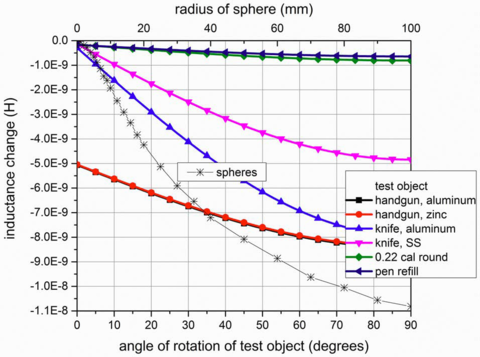
The primary innovation in the HWMD and HHMD standards was the introduction of spherical test objects instead of the typical abstraction (see Fig. 1) of a threat object. The concern with using nonspherical test objects to test the detection performance of the HWMD is that the detectability of that test object is dependent on its orientation (see Fig. 2). Figure 2 only shows the basic change in inductive coupling due to the orientation of the test object relative to the magnetic fields generated by the HWMD or the HHMD. The simulation does not represent an actual detection circuit of a metal detector. The test-object-orientation effect can be significantly enhanced by the metal detector, depending on the design of its circuitry. As an example, for HHMDs, manufacturers have observed a 20 x to 300x change in the amplitude of the detection signal for different exemplars when comparing minimum and maximum detectability orientations. This orientation effect may cause a metal detector to be classified with a better detectability than it can provide. An example will help explain this. The performance of a metal detector is currently based on alarming if a test object is presented to the metal detector in the orientation of that test object that renders it least detectable. If a metal detector is tested using a test object whose rotation is off by a few degrees from that minimum-detectability orientation and the metal detector alarms, this does not mean that the metal detector will find that test object if the test object was truly in its minimum-detectability orientation. But, without more accurate testing, the claim will be made that the particular metal detector can detect the test object in its minimum-detectability orientation. The observation by the manufacturers further supports the importance to use test objects that will not give a detection result that is sensitive to orientation of the test object.
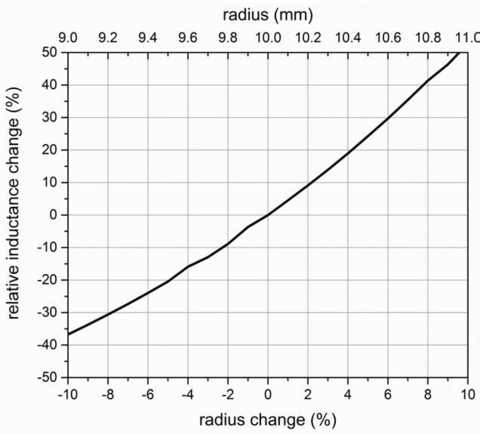
The recommendation to use spherical test objects was made by members of the ASTM working group for development of a HWMD performance standard. NIST subsequently investigated this recommendation, which resulted in the information shown here. This information was presented back to the ASTM HWMD working group, and general accord was obtained to use spherical test objects. The use of spherical test objects for testing the performance of the
HWMD constitutes a baseline technical performance test. This baseline performance is the least performance that should be expected from a HWMD when used in security and safety applications. If the agency has specific threats they wish to consider, the HWMD should be tested against those threats as well. The ASTM documentary performance standard for HWMDs includes analysis for testing with other-than-spherical test objects. The ASTM F3020- 16(2016), “Performance Standard for Hand-Worn Metal Detectors Used in Safety and Security,” was the end product of the ASTM’s HWMD working group deliberations.
Subsequently, an ASTM working group for a HHMD performance standard was initiated and led by NIST. This working group deliberated on the use of spherical test objects. Although technical accord was reached to include spherical test objects in the HHMD documentary performance standard, there was some concern about the applicability of spherical test objects to the wide variety of HHMD designs available on the market. This concern is based on the fact that different models of HHMDs have significantly different designs and will exhibit different threat object detectability. However, this difference in detectability will also be manifested for spheres, but without the inherent orientation effects of nonspherical test objects. These orientation effects are to the detriment of the user of the HHMD as was described for the HWMD previously. The use of spheres defines the baseline technical performance of the HHMD. Testing with actual threats or simulated threats presents operational testing, which may be necessary for an agency to include in their evaluation of a product that will eventually be employed in their security applications and scenarios. To help such agencies, the ASTM HHMD working group includes in the ASTM F3278- 17(2017), “Performance Standard for Hand-Held Metal Detectors Used in Safety and Security,” analysis for nonspherical test objects.
Walk-Through Metal Detectors
Walk-through metal detectors (WTMDs) can be found at almost every security checkpoint in the world. The WTMD is the mainstay for screening of concealed objects on people. The WTMD can and does find objects hidden in body cavities and under the skin, which other advanced security technologies, at ten-times the price, cannot.
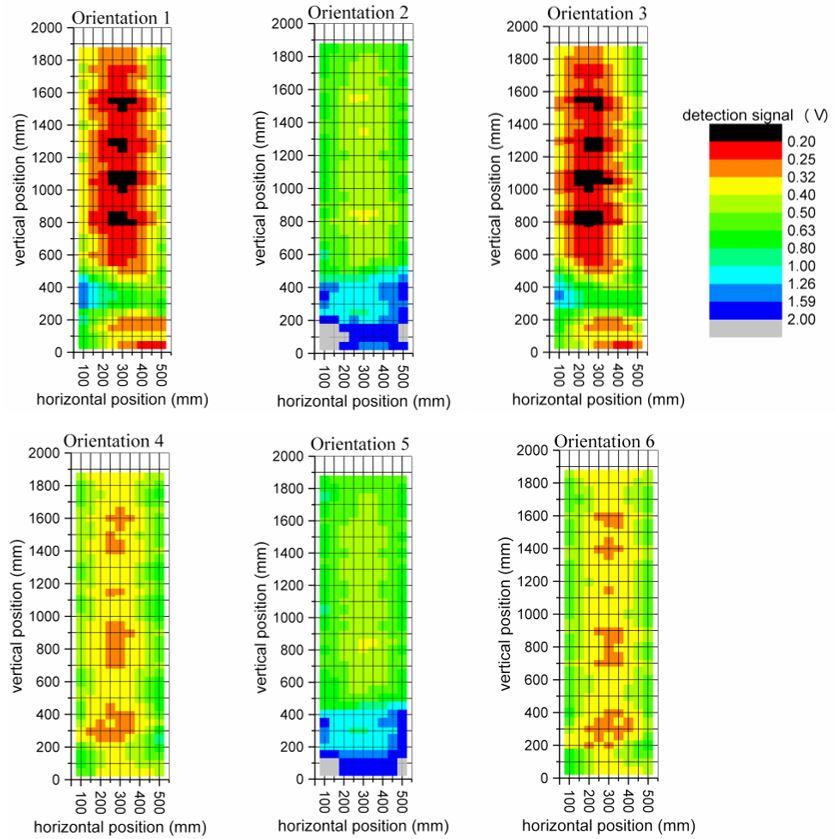
Recently, the effect of nonrectilinear trajectories of an object through the portal of the WTMD was shown to affect the detectability of that object. These nonrectilinear trajectories represent natural human motion such as head bob, arm sway, etc. To examine this effect more rigorously on test methods for inclusion in a WTMD documentary performance standard, an experimental study was performed. Because this study was to inform the development of test methods and selection of test objects for such a documentary standard, the study was expanded to also include the effect of the speed of the test object through the portal, the entry point of the test object into the portal, and the orientation of the different test objects. What was initially discovered that to thoroughly test the performance of the WTMD for the different test objects, their orientations, different entry point locations, and different nonrectilinear trajectories would require almost 9000 hr.
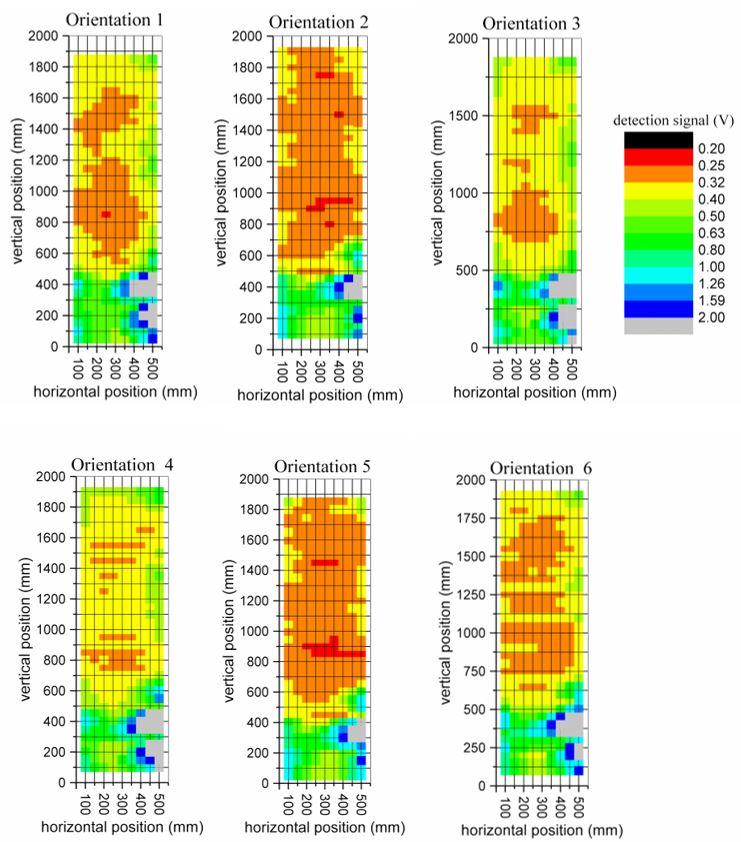
Different WTMDs and different sensitivity settings of these WTMDs were examined. The results are shown, by example, in Figs. 5 and 6. The results of this study showed that much of the parameters in the test process can be reduced because of the nature of the interaction of the WTMD with the test object. For example, of the six possible orientations of a test object can be presented to the WTMD, only the least detectable orientation is necessary. The study showed which orientation would be the least detectable based on the geometry of the test object. Based on this study, the number of speeds could be reduced from three or four to one as well as the number of trajectories from ten to one. All these reductions would provide test methods that thoroughly, accurately, and reproducibly assess the object detectability performance of the WTMD in less than 70 hr.
Collaborators
Donald Larson, Entegra Corp
John A. Ely, Correctional Security Consultant
Federal Bureau of Prisons, Office of Security Technology
Command, Control, and Interoperability Center for Advanced Data Analysis, Rutgers University
Results
Led development of ASTM hand-worn metal detector standard, published in 2016
Led development of ASTM hand-held metal detector standard, published in 2017.
Related Content
Publications
- NIJ Std 0602.01, “Walk-Through Metal Detectors for Use in Concealed Weapon and Contraband Detection,” National Institute of Justice, Office of Science and Technology, Washington, DC 20531, September 2000.
- NIJ Std 0602.01, “Hand-Held Metal Detectors for Use in Concealed Weapon and Contraband Detection,” National Institute of Justice, Office of Science and Technology, Washington, DC 20531, September 2000.
- NIJ Std 0602.01, “Walk-Through Metal Detectors for Use in Concealed Weapon and Contraband Detection,” National Institute of Justice, Office of Science and Technology, Washington, DC 20531, January 2003.
- NIJ Std 0602.01, “Hand-Held Metal Detectors for Use in Concealed Weapon and Contraband Detection,” National Institute of Justice, Office of Science and Technology, Washington, DC 20531, November 2003.
- ASTM F1468 - 04a(2010), “Standard Practice for Evaluation of Metallic Weapons Detectors for Controlled Access Search and Screening,” ASTM International, West Conshohocken, PA, 2010, www.astm.org.
- S.F. Hallowell, “Screening people for illicit substances: a survey of current portal technology,” Talanta, Vol. 54, 2001, pp. 447 to 458.
- B. Elias, “Airport body scanners: The role of advanced imaging technology in airline passenger screening, “Congressional Research Service, CRS Report for Congress R42750, September 2012.
- N.G. Paulter, D.R. Larson, and N.F. Troje, “Walk-through Metal Detector Testing and the Need to Emulate Natural Body Motion,” submitted to ASTM International - Journal of Testing and Evaluation, 2017.
- C. Nelson, V. Chaudhary, J. Edman, and P. Kantor, “Walk-Through Metal Detectors for Stadium Security,” Proceedings of the 2016 IEEE Symposium on Technologies for Homeland Security 10 to 11 May 2016, Waltham, Massachusetts, USA.
- C. Nelson, P. Kantor, B. Nakamura, B. Ricks, R. Whylaw, D. Egan, A. Matlin, F. Roberts, M. Tobia, and M. Young, “Experimental Designs for Testing Metal Detectors at a Large Sports Stadium” Proceedings of the 2015 IEEE Symposium on Technologies for Homeland Security, 14 to 15 April 2015, Waltham, Massachusetts, USA.
- J. Skorupski and P. Uchronski, “A Fuzzy Model for Evaluating Metal Detection Equipment at Airport Security Screening Checkpoints,” International Journal of Critical Infrastructure Protection, Vol. 16, 2017, pp. 39 to 48.
- N.G. Paulter, D.R. Larson, and R.H. Palm, NISTIR 6530, “A measurement system for characterizing the detection performance of metal detectors: design and operation,” National Institute of Standards and Technology, Gaithersburg, MD, June 2000.
- N.G. Paulter, D.R. Larson, and J.A. Ely, “Test object for accurate and reproducible measurement of the detection response of hand-worn and hand-held metal detectors,” Journal of Research of the National Institute of Standards and Technology, Volume 121 (2016) http://dx.doi.org/10.6028/jres.121.019.
- N.G. Paulter, D.R. Larson, and J.A. Ely, “Hand-held metal detector characterization using spherical test objects,” submitted to ASTM International - Journal of Testing and Evaluation, 2017.
- ASTM F3020- 16(2016), “Performance Standard for Hand-Worn Metal Detectors Used in Safety and Security,” ASTM International, West Conshohocken, PA, 2010, USA, www.astm.org.
- ASTM F3278- 17(2017), “Performance Standard for Hand-Worn Metal Detectors Used in Safety and Security,” ASTM International, West Conshohocken, PA, 2010, USA, www.astm.org.
Links
- ASTM documentary performance standard for hand-worn metal detectors: https://www.astm.org/Standards/F3020.htm
- ASTM testing guide for walk-through metal detectors: https://www.astm.org/Standards/F1468.htm
Contacts
-
(301) 975-8009

